
A chinrest is a shaped piece of wood (or plastic) attached to the body of a violin or a viola to aid in the positioning of the player's jaw or chin on the instrument. The chinrest may be made of ebony, rosewood, boxwood, or plastic.

A chinrest is a shaped piece of wood (or plastic) attached to the body of a violin or a viola to aid in the positioning of the player's jaw or chin on the instrument. The chinrest may be made of ebony, rosewood, boxwood, or plastic.
The chinrest was invented by Louis Spohr in the early 19th century, about 1820.[ citation needed ] Historically, this has been explained as a response to increasingly difficult repertoire which demanded freer left hand techniques than had previously been used; however, Spohr intended his small block attached to the bout to protect the tailpiece, which he reportedly broke with his vigorous playing.[ citation needed ] However, after being promoted by prominent violinists of the day, such as Pierre Baillot and Giovanni Battista Viotti, it gained quick acceptance among most violinists and violists and is today considered a standard part of the violin and viola. [1]

The chinrest is attached to the instrument by one or two metal clamps that hook over the edge of the back. One or two turnbuckles or machine screws provide slight clamping tension to hold the chinrest in place. In most cases, two screws are joined by a metal bar that conforms to the back edge of the instrument, whereas "Hill-style" clamps are used in a pair, each clamp having its own foot and its own screw, with no bar joining them. The clamps and the chinrest itself are usually padded with cork, leather, or felt where they contact the instrument to minimize damage to the wood. [2]
For side-mount chinrests, the clamp is placed on the bass side of the instrument; center-mount rests are placed so that the chinrest straddles the tailpiece. The latter may be considered a safer installation, as the clamps get support from the bottom block, and there is less chance that overtightening will cause damage.
A special pin wrench may be used for easy adjustment of the clamp tension without damaging the rib of the violin. The clamps of some modern chinrests are adjusted with a Torx or small Phillips screwdriver, or with a hex key.
Spohr's original design called for a small block of wood to be centered over the tailpiece, but soon evolved. Today, there are at least 50 different types of chinrests available. [1]

One of the most popular type of chinrest is the "Guarneri" type, whose attachment is centered over the tailpiece with the cup for the chin to the left of the tailpiece.
Some players prefer a chinrest with the cup centered over the tailpiece. The "Flesch" chinrest is of this type.
As described in the preceding section, some chinrests attach to the left of the end pin.
Chinrests are available in different heights and shapes. Violin and viola pedagogue Susan Kempter advocates having a luthier customize the chinrest by shaping it to fit the player's jaw properly and either raising or reducing the height until it fits the player's neck height as well. [3]
The chinrest should be placed so it does not touch or buzz against the tailpiece or belly of the instrument. [2]
Pressure from the chinrest against the player's skin can result in a common irritation known as "fiddler's neck" or "plague". It can also be caused by bacteria or fungus living on the wood or by an allergic reaction to the metals used in the chinrest. Some players prefer to use a cloth, such as a handkerchief, to cover the chinrest, to avoid this irritation and make playing more comfortable. Several types of padded fabric slipcovers are also commercially available. They may not only cover the chinrest cup, but also extend to provide a barrier between the metal clamp hardware and the skin—beneficial if the hardware is plated with nickel and the player is allergic to the metal. Hypo-allergenic chinrests (with plastic or titanium fittings) are also available.
Vociferous debate may be elicited in some circles by suggesting that a violin sounds better without a chinrest, or that better technique and posture is developed without it. The chinrest did not significantly increase the playability of the violin. It has been suggested that Paganini played without a chinrest, and there is significant evidence to suggest; he played mostly on a short-necked violin more akin to the Baroque instrument, and used gut strings, and is always depicted in his famous posture—that is further suggestion he isn't using a chinrest. A few professionals today also eschew the use of a chinrest on their modern instruments.

The cello ( CHEL-oh), or violoncello ( VY-ə-lən-CHEL-oh, Italian pronunciation: [vjolonˈtʃɛllo]), is a bowed (sometimes plucked and occasionally hit) string instrument of the violin family. Its four strings are usually tuned in perfect fifths: from low to high, C2, G2, D3 and A3. The viola's four strings are each an octave higher. Music for the cello is generally written in the bass clef, with tenor clef, and treble clef used for higher-range passages.

The double bass, also known simply as the bass, amongst other names, is the largest and, therefore, lowest-pitched chordophone in the modern symphony orchestra. Similar in structure to the cello, it has four, although occasionally five, strings.

An electric guitar is a guitar that requires external amplification in order to be heard at typical performance volumes, unlike a standard acoustic guitar. It uses one or more pickups to convert the vibration of its strings into electrical signals, which ultimately are reproduced as sound by loudspeakers. The sound is sometimes shaped or electronically altered to achieve different timbres or tonal qualities from that of an acoustic guitar via amplifier settings or knobs on the guitar. Often, this is done through the use of effects such as reverb, distortion and "overdrive"; the latter is considered to be a key element of electric blues guitar music and jazz and rock guitar playing. Designs also exist combining attributes of the electric and acoustic guitars: the semi-acoustic and acoustic-electric guitars.

The guitar is a fretted musical instrument that typically has six strings. It is usually held flat against the player's body and played by strumming or plucking the strings with the dominant hand, while simultaneously pressing selected strings against frets with the fingers of the opposite hand. A plectrum or individual finger picks may also be used to strike the strings. The sound of the guitar is projected either acoustically, by means of a resonant chamber on the instrument, or amplified by an electronic pickup and an amplifier.
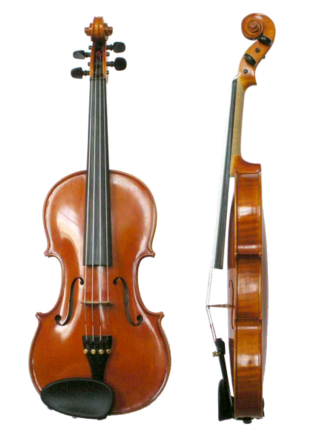
The violin, sometimes known as a fiddle, is a wooden chordophone in the violin family. Most violins have a hollow wooden body. It is the smallest and thus highest-pitched instrument (soprano) in the family in regular use. The violin typically has four strings, usually tuned in perfect fifths with notes G3, D4, A4, E5, and is most commonly played by drawing a bow across its strings. It can also be played by plucking the strings with the fingers (pizzicato) and, in specialized cases, by striking the strings with the wooden side of the bow.

String instruments, stringed instruments, or chordophones are musical instruments that produce sound from vibrating strings when a performer plays or sounds the strings in some manner.

A mute is a device attached to a musical instrument which changes the instrument's tone quality (timbre) or lowers its volume. Mutes are commonly used on string and brass instruments, especially the trumpet and trombone, and are occasionally used on woodwinds. Their effect is mostly intended for artistic use, but they can also allow players to practice discreetly. Muting can also be done by hand, as in the case of palm muting a guitar or grasping a triangle to dampen its sound.
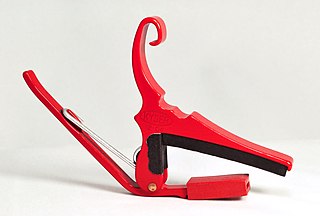
A capo is a device a musician uses on the neck of a stringed instrument to transpose and shorten the playable length of the strings—hence raising the pitch. It is a common tool for players of guitars, mandolins, mandolas, banjos, ukuleles and bouzoukis. The word derives from the Italian capotasto, which means the nut of a stringed instrument. The earliest known use of capotasto is by Giovanni Battista Doni who, in his Annotazioni of 1640, uses it to describe the nut of a viola da gamba. The first patented capo was designed by James Ashborn of Wolcottville, Connecticut year 1850.
In music, a bow is a tensioned stick which has hair coated in rosin affixed to it. It is moved across some part of a musical instrument to cause vibration, which the instrument emits as sound. The vast majority of bows are used with string instruments, such as the violin, viola, cello, and bass, although some bows are used with musical saws and other bowed idiophones.
The fingerboard is an important component of most stringed instruments. It is a thin, long strip of material, usually wood, that is laminated to the front of the neck of an instrument. The strings run over the fingerboard, between the nut and bridge. To play the instrument, a musician presses strings down to the fingerboard to change the vibrating length, changing the pitch. This is called stopping the strings. Depending on the instrument and the style of music, the musician may pluck, strum or bow one or more strings with the hand that is not fretting the notes. On some instruments, notes can be sounded by the fretting hand alone, such as with hammer ons, an electric guitar technique.

A Baroque violin is a violin set up in the manner of the baroque period of music. The term includes original instruments which have survived unmodified since the Baroque period, as well as later instruments adjusted to the baroque setup, and modern replicas. Baroque violins have become relatively common in recent decades thanks to historically informed performance, with violinists returning to older models of instrument to achieve an authentic sound.

A tailpiece is a component on many stringed musical instruments that anchors one end of the strings, usually opposite the end with the tuning mechanism.
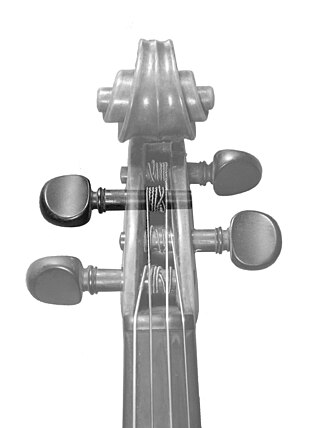
A variety of methods are used to tune different stringed instruments. Most change the pitch produced when the string is played by adjusting the tension of the strings.
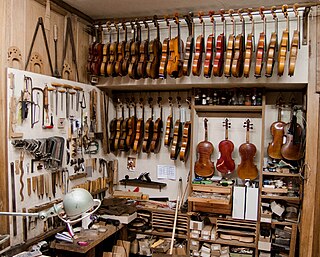
Making an instrument of the violin family, also called lutherie, may be done in different ways, many of which have changed very little in nearly 500 years since the first violins were made. Some violins, called "bench-made" instruments, are made by a single individual, either a master maker or an advanced amateur, working alone. Several people may participate in the making of a "shop-made" instrument, working under the supervision of a master. This was the preferred method of old violin makers who always put their names on violins crafted by their apprentices. Various levels of "trade violin" exist, often mass-produced by workers who each focus on a small part of the overall job, with or without the aid of machinery.

A violin consists of a body or corpus, a neck, a finger board, a bridge, a soundpost, four strings, and various fittings. The fittings are the tuning pegs, tailpiece and tailgut, endpin, possibly one or more fine tuners on the tailpiece, and in the modern style of playing, usually a chinrest, either attached with the cup directly over the tailpiece or to the left of it. There are many variations of chinrests: center-mount types such as Flesch or Guarneri, clamped to the body on both sides of the tailpiece, and side-mount types clamped to the lower bout to the left of the tailpiece.

Playing the violin entails holding the instrument between the jaw and the collar bone. The strings are sounded either by drawing the bow across them (arco), or by plucking them (pizzicato). The left hand regulates the sounding length of the strings by stopping them against the fingerboard with the fingers, producing different pitches.

The violin, viola and cello were first built in the early 16th century, in Italy. The earliest evidence for their existence is in paintings by Gaudenzio Ferrari from the 1530s, though Ferrari's instruments had only three strings. The Académie musicale, a treatise written in 1556 by Philibert Jambe de Fer, gives a clear description of the violin family much as we know it today.

The shoulder rest is an accessory that can be found on violins and violas. The shoulder rest appeared around the middle part of the 20th century. It may be made of wood, aluminium, carbon fiber or plastic. Usually, the shoulder rest attaches to the edge of the back of the violin with "feet" padded with rubber tubing or made of soft plastic. The goal of a shoulder rest is to allow a more comfortable attitude while playing by adding height to the shoulder and preventing the instrument from slipping. A shoulder rest generally follows the curve of the shoulder; some shoulder rests are bendable, others are made of sponge-like material, and a few have an extension that hooks further over the shoulder for stability.
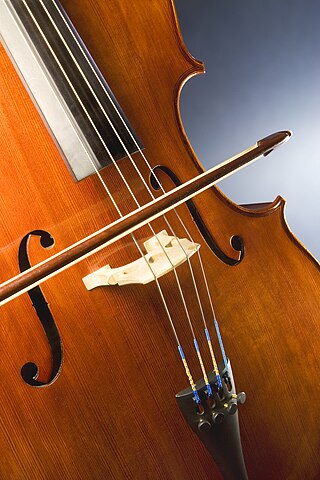
A bridge is a device that supports the strings on a stringed musical instrument and transmits the vibration of those strings to another structural component of the instrument—typically a soundboard, such as the top of a guitar or violin—which transfers the sound to the surrounding air. Depending on the instrument, the bridge may be made of carved wood, metal or other materials. The bridge supports the strings and holds them over the body of the instrument under tension.
Fiddler's neck is an occupational disease that affects violin and viola players.
{{cite book}}: CS1 maint: location (link)